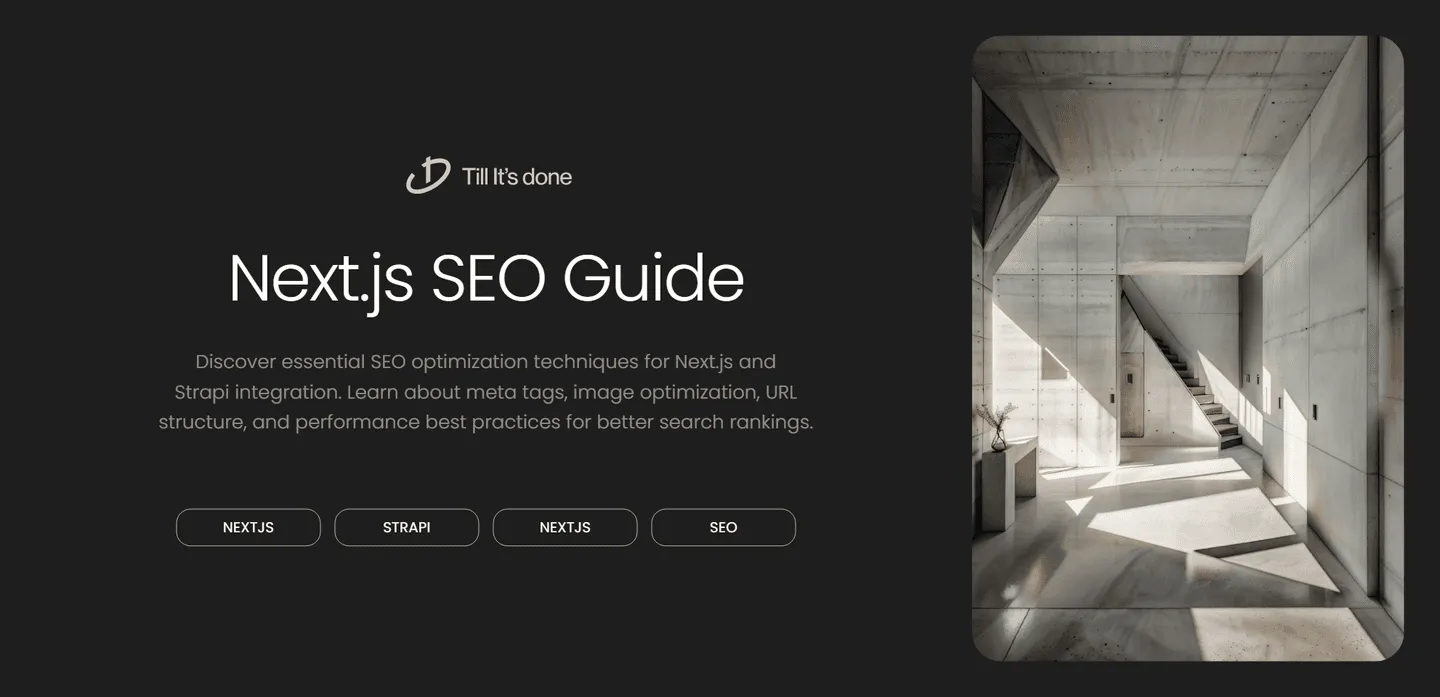- Services
- Case Studies
- Technologies
- NextJs development
- Flutter development
- NodeJs development
- ReactJs development
- About
- Contact
- Tools
- Blogs
- FAQ
Best Practices for SEO in Next.js with Strapi
Learn about meta tags, image optimization, URL structure, and performance best practices for better search rankings.

Best Practices for SEO in Next.js with Strapi
![]()
Building a well-optimized website is crucial for success in today’s digital landscape. When combining Next.js with Strapi CMS, you have a powerful stack that can help you achieve excellent SEO results. Let’s dive into the best practices that will help your content rank higher and perform better in search engines.
Setting Up Meta Tags Dynamically
One of the most fundamental aspects of SEO is properly implementing meta tags. With Next.js and Strapi, you can dynamically generate these tags based on your content. Strapi makes it easy to manage SEO fields for each piece of content, while Next.js provides excellent tools for rendering them.
Create dedicated SEO fields in your Strapi content types, including title, description, and Open Graph images. This structured approach ensures consistency across your website while maintaining flexibility for individual pages.
![]()
Optimizing Image Delivery
Images play a crucial role in both user experience and SEO. Next.js’s Image component combined with Strapi’s media library creates a powerful system for image optimization. Configure your images to use modern formats like WebP, implement lazy loading, and ensure proper sizing across different devices.
URL Structure and Dynamic Routes
Creating SEO-friendly URLs is essential for both users and search engines. Implement a clean URL structure using Next.js’s dynamic routing capabilities. With Strapi, you can define custom slugs for your content and easily map them to your Next.js routes.
![]()
Performance Optimization
Performance is a critical ranking factor. Leverage Next.js’s built-in performance features like automatic code splitting and static generation. When fetching data from Strapi, implement effective caching strategies and use incremental static regeneration for content that updates frequently.
Implementing Structured Data
Rich snippets can significantly improve your search appearance. Create dynamic structured data based on your Strapi content. Whether it’s articles, products, or other content types, properly structured JSON-LD will help search engines better understand your content.
Content Architecture
Organize your content in Strapi with SEO in mind. Create relationships between content types to build topic clusters and implement proper internal linking. Use Next.js’s static generation to create landing pages for categories and tags that help search engines understand your site’s structure.
Monitoring and Analytics
Implement comprehensive analytics to track your SEO performance. Set up tools like Google Search Console and integrate them with your Next.js application. Monitor your core web vitals and make data-driven decisions to improve your SEO strategy.
![]()
Remember, SEO is an ongoing process that requires constant attention and optimization. By following these best practices and leveraging the powerful features of both Next.js and Strapi, you’ll be well on your way to achieving better search engine rankings and increased organic traffic.
 สร้างเว็บไซต์ 1 เว็บ ต้องใช้งบเท่าไหร่? เจาะลึกทุกองค์ประกอบ website development cost อยากสร้างเว็บไซต์แต่ไม่มั่นใจในเรื่องของงบประมาณ อ่านสรุปเจาะลึกตั้งแต่ดีไซน์, ฟังก์ชัน และการดูแล พร้อมตัวอย่างงบจริงจาก Till it’s done ที่แผนชัด งบไม่บานปลายแน่นอน
สร้างเว็บไซต์ 1 เว็บ ต้องใช้งบเท่าไหร่? เจาะลึกทุกองค์ประกอบ website development cost อยากสร้างเว็บไซต์แต่ไม่มั่นใจในเรื่องของงบประมาณ อ่านสรุปเจาะลึกตั้งแต่ดีไซน์, ฟังก์ชัน และการดูแล พร้อมตัวอย่างงบจริงจาก Till it’s done ที่แผนชัด งบไม่บานปลายแน่นอน  Next.js สอน 14 ขั้นตอนเบื้องต้น: สร้างโปรเจกต์แรกใน 30 นาที เริ่มต้นกับ Next.js ใน 14 ขั้นตอนเพียงแค่ 30 นาที พร้อม SSR/SSG และ API Routes ด้วยตัวอย่างโค้ดง่าย ๆ อ่านต่อเพื่อสร้างโปรเจ็กต์แรกได้ทันทีที่นี่
Next.js สอน 14 ขั้นตอนเบื้องต้น: สร้างโปรเจกต์แรกใน 30 นาที เริ่มต้นกับ Next.js ใน 14 ขั้นตอนเพียงแค่ 30 นาที พร้อม SSR/SSG และ API Routes ด้วยตัวอย่างโค้ดง่าย ๆ อ่านต่อเพื่อสร้างโปรเจ็กต์แรกได้ทันทีที่นี่  วิธีสมัคร Apple Developer Account เพื่อนำแอปขึ้น App Store ทีละขั้นตอน อยากปล่อยแอปบน App Store ระดับโลก มาอ่านคู่มือสมัคร Apple Developer Account พร้อมเคล็ดลับ TestFlight และวิธีอัปโหลดที่ง่ายในบทความเดียวนี้ได้เลย
วิธีสมัคร Apple Developer Account เพื่อนำแอปขึ้น App Store ทีละขั้นตอน อยากปล่อยแอปบน App Store ระดับโลก มาอ่านคู่มือสมัคร Apple Developer Account พร้อมเคล็ดลับ TestFlight และวิธีอัปโหลดที่ง่ายในบทความเดียวนี้ได้เลย  TypeScript Interface คืออะไร? อธิบายพร้อมวิธีใช้และข้อแตกต่างจาก Type เรียนรู้วิธีใช้ TypeScript Interface เพื่อสร้างโครงสร้างข้อมูลที่ปลอดภัยและเข้าใจง่าย พร้อมเปรียบเทียบข้อดีข้อแตกต่างกับ Type ที่คุณต้องรู้ ถูกรวมเอาไว้ในบทความนี้แล้ว
TypeScript Interface คืออะไร? อธิบายพร้อมวิธีใช้และข้อแตกต่างจาก Type เรียนรู้วิธีใช้ TypeScript Interface เพื่อสร้างโครงสร้างข้อมูลที่ปลอดภัยและเข้าใจง่าย พร้อมเปรียบเทียบข้อดีข้อแตกต่างกับ Type ที่คุณต้องรู้ ถูกรวมเอาไว้ในบทความนี้แล้ว  Material-UI (MUI) คืออะไร อยากสร้าง UI สวยงามและเป็นมืออาชีพในเวลาอันรวดเร็วใช่ไหม มาทำความรู้จักกับ Material-UI (MUI) ที่ช่วยให้คุณพัฒนาแอปพลิเคชันบน React ได้ง่ายและดูดีในทุกอุปกรณ์
Material-UI (MUI) คืออะไร อยากสร้าง UI สวยงามและเป็นมืออาชีพในเวลาอันรวดเร็วใช่ไหม มาทำความรู้จักกับ Material-UI (MUI) ที่ช่วยให้คุณพัฒนาแอปพลิเคชันบน React ได้ง่ายและดูดีในทุกอุปกรณ์  เปรียบเทียบ 3 วิธีติดตั้ง install node js บน Ubuntu: NVM vs NodeSource vs Official Repo แบบไหนดีที่สุด? เรียนรู้วิธีติดตั้ง Node.js บน Ubuntu ด้วย NVM, NodeSource หรือ Official Repo เลือกวิธีที่เหมาะกับความต้องการของคุณ พร้อมเปรียบเทียบ เพื่อการพัฒนาที่มีประสิทธิภาพ!
เปรียบเทียบ 3 วิธีติดตั้ง install node js บน Ubuntu: NVM vs NodeSource vs Official Repo แบบไหนดีที่สุด? เรียนรู้วิธีติดตั้ง Node.js บน Ubuntu ด้วย NVM, NodeSource หรือ Official Repo เลือกวิธีที่เหมาะกับความต้องการของคุณ พร้อมเปรียบเทียบ เพื่อการพัฒนาที่มีประสิทธิภาพ! พูดคุยกับซีอีโอ
We'll be right here with you every step of the way.
We'll be here, prepared to commence this promising collaboration.
Whether you're curious about features, warranties, or shopping policies, we provide comprehensive answers to assist you.


